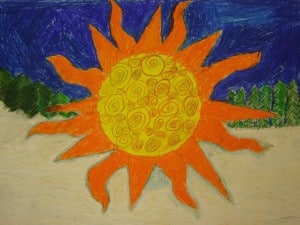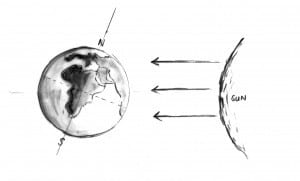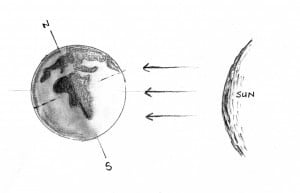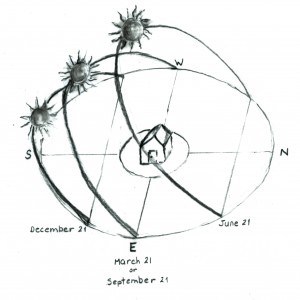Caught up in the hustle and bustle of the holiday season, many of us forget that a profound celestial event takes place this month. Monday, December 21, marks the occasion of the winter solstice, the shortest day of the year and the first official day of winter. From our perspective, we see the sun tracing its lowest and shortest arc through the sky. Even at noon, it climbs no higher than halfway above the southern horizon. The sun is now rising far to the southeast and setting in the southwest, which means that its trajectory through the sky is also at its shortest. The result is that day length is at its shortest, too. At the solstice, Peterborough receives only eight hours and 51 minutes of daylight. Compare this to the 15 hours and 32 minutes we enjoy at the summer solstice.
To understand why all of this is happening, think of a globe. You have probably noticed that a globe is not straight up and down; it is tilted. This is because the imaginary line between the Earth’s north and south poles (the axis) is on an angle (23.5 degrees). Because the Earth spins along this axis as it orbits around the sun, the northern hemisphere ends up being tilted toward the sun for part of the year — our spring and summer — and away from the sun for part of the year — our fall and winter. This tilt causes a huge difference in the amount of heating the Earth’s surface receives from one season to the next.
In summer, sunlight strikes the northern hemisphere – our part of the globe – much more directly (perpendicularly) than during other times of the year. The land is therefore heated more efficiently. The solar radiation also takes a shorter path through the energy-absorbing atmosphere before striking the Earth. This also means that shadows at noon are very short. In winter, however, sunlight strikes the Kawarthas at a greater angle, given the sun’s position lower in the sky. The light also travels through more atmosphere and scatters over a larger area. The net result is that far less heating occurs and shadows are longer.
The tilting also means that there are more hours of daylight in the summer and fewer hours in the winter. This makes a huge difference in the lives of plants and animals, be it the rapid plant growth and reproductive frenzy of sun-soaked June or the dormant plants and avian silence of December. One of the main reasons that birds migrate north in the spring — instead of staying in the tropics, for example — is to take advantage of the longer days of the northern summer. They provide more time for birds to gather food for their young, which leads to greater reproductive success.
The winter solstice represents the assurance that the days will once again grow longer and spring indeed will come. It is an event that was noticed and celebrated by ancient cultures all over the northern hemisphere. A growing number of people are once again celebrating the spiritual and symbolic dimensions of the solstice, often as a part of Christmas and other holiday season festivities. You and your family may wish to try some of the following activities.
Flashlight Sun: The difference in heating between the summer and winter can be demonstrated with a flashlight – the stronger, the better. Try this. Shine your flashlight directly over a tabletop so that the beam is nearly vertical. You will notice that the light is concentrated in a small area. If your flashlight is strong enough, the tabletop will soon feel warm to the touch. The light beam is just like the solar radiation of early summer when the sun is high in the sky. If you place a small, vertical object on the table, you will also see that it casts a short shadow. To simulate winter, angle your flashlight to the side so that the light scatters over a larger area. You should be able to feel that far less heating occurs, because the same amount of light spreads out over a larger area. The shadow cast by the object on the table will be much longer, as well. This difference in the angle of the light between summer and winter is what explains the huge differences in temperature.
Sun-watching: From a window, from outside in your yard or from a height of land such as Armour Hill in Peterborough, try to get as unobstructed a view as possible of the eastern and/or western horizon. On or near the winter solstice, take note of exactly where the sun rises and/or sets in relation to landmarks such as trees, buildings, etc. Make a sketch or take a photograph of the rising and/or setting sun. Do the same at the spring equinox, summer solstice and fall equinox. Make sure to observe from exactly the same spot. You will be amazed by the change in sunrise and sunset points with each new season. As spring approaches, you will see the sun rise and set progressively northward. After the summer solstice, however, the sunrise and sunset points move south.
Solstice Corsage: Head out for a solstice nature walk, taking along some thread. As you walk, watch for any small natural objects that catch your attention (e.g., small section of a conifer twig, bark with lichen, a dry flower head) Bind the objects together with the thread. You may wish to make a loop so that you can attach it to a button on your coat. You could also wear it around your wrist. When your walk is over, you will be able to take your memories of that special outing with you!
Ice Lanterns: You will need balloons (any size), colored dye (optional), a large bowl, water and tea light candles. If you want to use dye, add a few drops inside the balloon. Attach the balloon to a water faucet, fill it to the desired size and tie it off. Put the balloon in a bowl and place it either outside or in a freezer. Wait about six hours or until the outside of the balloon is frozen but there is still water inside. Carefully cut and peel away the balloon. Working over a sink or outside, drain the water away by making a hole in the weakest part of the base using a kitchen knife. The hole will have to be large enough to slip over the tea candle. Refreeze the globe until completely solid. Make a hole at the top, with either a drill or a flame. Place your candle outdoors and cover with the ice lantern. Enjoy!
Wildlife Tree: Decorate an outside tree (preferably near a window) for the birds and other animals. Conifers work well. String pieces of apple, dried fruit, peanuts in the shell and popcorn over the boughs. You can also hang pieces of suet from the tree or pine cones covered in peanut butter and rolled in bird seed. It won’t be long before wildlife discover your creation.
Winter Wildflower Bouquet: The grey, brittle remains of last summer’s field and roadside flowers have a beauty and grace all their own, especially if you take time to look at them closely. Here is a great way to decorate the dining room table. When you are out for a walk, why not snip off a few and make your own winter floral arrangement? Some of the most attractive are the dry stalks and seedpods of milkweed, Queen Anne’s lace (wild carrot), evening primrose, mullein, burdock and the numerous types of grass. For a splash of colour try adding some of the fruit that often still lingers on shrubs and vines in early winter such as sumac, mountain-ash, and highbush-cranberry. A little greenery from a cedar or other conifer also adds a nice touch.



